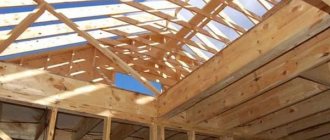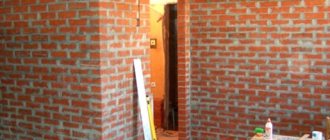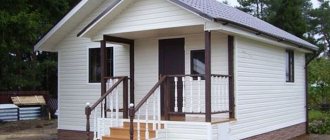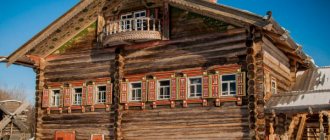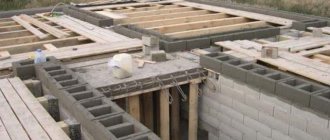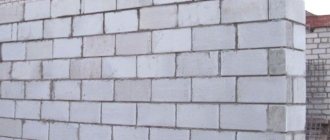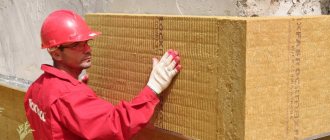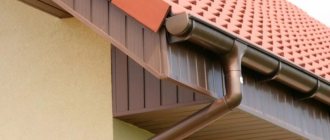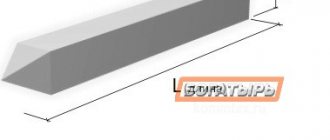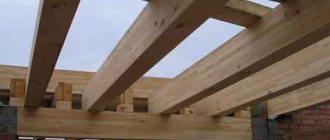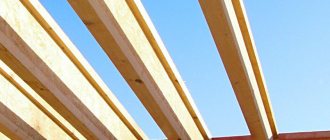Benefits of wood
Floors are horizontal structural elements of buildings and structures that divide them into floors or separate them from technical rooms (attic or basement). Depending on what material the building is constructed from, the floors can be monolithic, prefabricated reinforced concrete or wood.
For the construction of a private house, floors on wooden beams are most suitable, since their weight is less than that of structures made from other materials, and constructing them with your own hands is cheaper and easier.
Wooden interfloor ceilings can be installed in houses made of any material, with the exception of monolithic reinforced concrete. They are erected simultaneously with the construction of the walls, as the latter are built to the height of the next floor. In frame wooden buildings, floors can be made simultaneously with the construction of the frame of the entire building, even before it is insulated and covered.
Which material to choose?
Since the sound insulation of the floor in a wooden house differs from classical concrete floor plans, materials are selected specifically for the characteristics of the structure. The most popular and proven sound insulators are:
- Glass wool . They prefer to use it at the base of the first floor floor, since the material performs a dual function - insulation and sound absorption.
- Cotton wool containing basalt fibers . This material does an excellent job of sound insulation. It is resistant to fire, is not exposed to moisture and is able to muffle impact sounds.
- Felt is both an insulating and sound-absorbing material. It is easy for them to lay the joints of floors. However, the material is not resistant to combustion and will require special processing.
- Cork material is an excellent insulator of shock sounds. It is laid directly under the final floor covering.
Related article: Wenge color in the interior: choosing wallpaper and furniture
All these materials can be combined with each other. They are mainly used to eliminate noise and heat loss problems in wooden structures.
Soundproofing of the floor is installed at the time of construction, since it is very difficult to fix anything in a finished house. The presence of sound insulation contributes to comfortable and cozy living in a wooden house.
Correct floor design
Interfloor wooden floors are arranged on beams. They are usually used as timber. The size of the section depends on the size of the span that needs to be covered, as well as on the size of the expected load on the floor and the types of wood used. Most often, timber with a section width of 100 mm and a section height of 150-200 mm is used.
Next, the ceiling itself is formed by installing the floor boards of the upper floor and hemming the ceiling materials of the lower floor. You can often see that floor boards are laid directly on beams, but it is more correct to first install logs on the beams, and then make flooring from the boards over them. The second option is the most preferable, as it will allow for proper interfloor insulation along wooden beams.
The fact is that in the pie, which the filling of the interfloor ceiling is so similar to, there must be layers of vapor barrier.
They are made of a special membrane with a certain coefficient of vapor permeability, and the top layer of the membrane allows steam to pass in only one direction - from the insulation into the air. Therefore, an air gap is needed between the membrane and the plank floorboard, which will remove steam from under the boards. Otherwise, the latter will simply begin to rot.
In this case, the membrane is laid on the interfloor floor beams, and the air gap is formed due to the thickness of the logs laid perpendicular to the beams.
Steam is removed from under the boards through specially cut holes in the floor or slotted skirting boards used to edge the perimeter of the room.
Note! The bottom layer of the membrane must be made of a material with a very low vapor permeability coefficient.
This is necessary so that moisture from the lower rooms does not seep upward through the interfloor ceilings, and also does not linger in the layers of insulation. All air from the floor should be vented into the atmosphere only through ventilation ducts or windows for ventilation.
Membrane sound insulation of floors in a wooden house along the ceiling
The technique was described on one construction forum by a competent person, judging by the reviews. Those who have already done it say the effect is decent.
Sound insulation of wooden beam floors between floors with mineral wool or mineral slabs (heat and sound insulating slabs made of mineral wool, for example, TechnoNikol, Technofas, Rocklight, Izover ISOVER, etc.).
The brand of acoustic insulation is chosen at your discretion; all manufacturers have the same principle. The size and density vary (thickness from 40 to 100 mm, density 30-140 kg/m3). Available in the form of rolls or slabs of certain dimensions.
Attention! Installation of cotton wool is carried out strictly with safety glasses and a respirator.
The advantage of cotton wool is excellent sound absorption, in particular, high and partially mid frequencies are well damped. The rule here is that the thicker the layer, the more it can absorb (meaning the low frequency spectrum). It should be understood that it is low frequencies that are strongly transmitted through wooden floors and it is very difficult to get rid of their penetration. Why is that? It's simple - wooden floors are light in weight, and the wood acts as a resonator. It is easier to achieve sound insulation in concrete floors, due to the design features of the concrete slab and its properties.
However, if desired, it is possible to significantly reduce noise transmission through wooden floors. To do this, you need to make a sound absorber, which is a membrane-type cake.
Sound absorber membrane structure
The pie is made from sheet material, optionally OSB or plywood (no thinner than 10 mm). A sound insulator is placed inside (between the sheets). The following can be used as a sound absorber:
- Mineral wool (mineral wool)
- Basalt fiber
- Minplita
- Construction felt (technical)
If you use mineral wool material, then with a density of at least 30 kg/m3 (the higher the density and thicker, the better).
Construction felt is characterized by high sound absorption parameters, but is prone to water absorption and is fire hazardous (although high-quality antiseptic impregnation reduces the likelihood of fire, i.e. it does not burn openly, but smolders).
Construction (technical) felt is a dense material made from wool or synthetic fibers. Characteristics: density - 10-80 kg/m3, thickness 5-40 mm, width different, varies up to 2 meters, thermal conductivity from 0.03 to 0.07 W/(m•K). Available in rolls or in sheet form.
The sound absorber between the ceiling and the membrane is made not only for sound insulation, but mainly to dampen the resonance that occurs between the ceiling and the membrane.
Sound insulation of wooden floors - vibration suspension To achieve maximum sound insulation effect, the membrane (pie) should not be connected to the floor, i.e. must have an independent connection (attached to a separate profile at a distance of 10 cm from the ceiling, forming an air cushion). It turns out to be a kind of suspended ceiling.
Homemade vibration suspension The soundproofing cake is attached around the perimeter to the walls, and in the middle to the beams only by means of shock-absorbing fasteners (elastic ceiling suspension), and in rare increments, no less than a meter. You can buy factory-made vibration suspensions or make a homemade vibration-damping suspension.
If the membrane is screwed directly to wooden floor beams, the entire effect will be lost.
The principle of the technology is to desynchronize the sound vibrations that occur between the ceiling and the membrane. It turns out, so to speak, a ceiling with a resonant absorber.
Soundproofing wooden floors between floors - installing a sound-absorbing membrane
It is also possible to install such a design - mineral wool is attached with a mesh or slats between the floor beams, and the ceiling is hemmed with plywood or plasterboard as a membrane (i.e. instead of it). But they are not attached to beams, but also independently (i.e. behind the walls), 3-5 cm below the ceiling. With such a device, the role of an absorber will be played by mineral wool attached to the beams.
Insulation layers
So, if you imagine a cross-section of the interfloor insulation cake, it will consist of the following layers:
- upper floor flooring boards;
- logs;
- floor vapor barrier;
- beams with a layer of heat and sound insulation laid between them;
- ceiling vapor barrier;
- ceiling cladding.
In multi-storey buildings, insulation of the interfloor floor is relevant only if this floor is made between the basement and the first floor, as well as in the case of the floor between the upper floor and an unheated attic.
If the ceiling separates two residential heated floors, then the role of insulating material for insulation is negligible. In this case, the soundproofing properties of the structure are much more important. Despite the fact that heat and sound insulating materials are included in the same group when classified according to purpose and technological characteristics, their properties may be different.
These differences must be taken into account when using this or that material in a specific interfloor covering.
Soundproofing the ceiling in the house
Soundproofing the ceiling of a wooden floor between floors should provide a sufficient level of comfort for the residents of the house.
When installing a ceiling, a frame made of a metal profile is often used. For such a ceiling, use the following solutions:
- instead of CD hangers, special hangers with vibration pads are attached to the ceiling;
- the UD profile is mounted using vibration-isolating tape, which will prevent the transmission of vibration noise to the walls and ceiling;
- minimize the contact of the load-bearing parts of the frame and the soundproofing material;
- we fill the lathing with soundproofing material with a high sound absorption coefficient;
- seal the joints of the ceiling panels with a sealing compound and carefully insulate them;
- the places where the chimney passes through the ceiling are insulated with heat-resistant insulation.
When choosing a wooden frame, similar soundproofing techniques are used. The result is a sealed, hard and multi-layered ceiling with a thickness of 5-7 cm. For the finishing coating it is better to use a stretch ceiling. Plasterboard sheets create additional noise bridges.
Types of floor insulation
The logs are wide bars installed on an edge and running from wall to wall parallel to each other. Plastic or metal beams can also play their role. Next, the finished floor boards are attached to them, so it is very important to lay them correctly so that over time the floor does not begin to creak or deform.
The selected insulation option is placed between and sometimes under the joists. Let's try to figure out which material for floor insulation is better to give preference to, and which should be completely abandoned.
It is not necessary for the logs to be exactly boards. Often this is an ordinary beam, adjusted to the level in one plane. The main thing is to secure them well and level them so that subsequent laying of the floor does not bring problems to the homeowner.
We will consider the most popular types of insulation materials, which are distinguished by fairly high heat saving rates.
These included:
- sawdust or sawdust mixture;
- expanded clay;
- glass wool;
- mineral wool;
- ecowool;
- penoplex;
- expanded polystyrene.
All of the listed insulation materials are quite airy, which means they will let the cold through with great reluctance. In addition, a high-quality layer of insulation can prevent the appearance of high humidity in the house, which is also important.
Option No. 1 - budget sawdust
This material has the most unstable characteristics. Often, it becomes saturated with moisture, which significantly worsens its heat-protective properties.
In this case, the owner better take care of the bottom layer of waterproofing, since wet wood will begin to rot, and this can cause not only damage to the coating, but also a number of serious diseases.
Often, as a relatively inexpensive option, pellets or sawdust granules similar to pellets are used to insulate the floor. In them, sawdust is compressed and held in place by an adhesive base.
Such insulation will have slightly better thermal conductivity, but experts do not recommend insulating the floors of your home with such material. Its moisture resistance leaves much to be desired.
Of course, if you plan to insulate the floor in a country house or in an outbuilding, you can use sawdust, but they are completely unsuitable for insulating floors in a house. It is better not to save money, but to purchase more expensive and high-quality insulation.
According to experts, sawdust is one of the most undesirable materials for floor insulation. But the budgetary nature of the material often takes its toll. Experienced builders recommend using sawdust only when insulating the floor of outbuildings
Soundproofing walls in a private house
When installing an insulating barrier on the walls, it is necessary to take into account that a multi-layer structure can reduce the strength of sounds more than a thick single-layer structure. Therefore, to achieve greater efficiency, experts recommend laying soundproofing material in several layers or simultaneously laying 2 or 3 types of insulators.
Preparatory process
Proper soundproofing of walls in a private house begins with their preparation. First you need to carefully visually examine the surface of each wall, try to identify all possible cracks and holes. Any defect found must be eliminated using putty.
Note! Particular attention should be paid to sockets and switches. It is no secret that, to ensure ease of installation, electricians quite often drill holes in the wall for them. Thus, they create a kind of channel for the propagation of sounds. In this case, it is recommended to install a noise-insulating gasket between two adjacent sockets or switches.
Also, you need to seal the holes around the pipes of the heating system, cold and hot water supply. The best option is to use an elastic sealant.
Selecting materials
To soundproof walls, you can use various types of insulators. Quite often, when creating an insulating barrier, roll or sheet materials are used. And on top they are covered with plasterboard sheets.
But if you have limited usable room space, then you need to install structures made from sheet gypsum plasterboard. In this case, it is more rational to use cork covering. In addition, this environmentally friendly material will add a unique twist to the interior.
Mineral wool, polyethylene foam, polystyrene foam, felt, and acoustic foam in combination with Audek panels will also help provide excellent sound insulation.
We suggest considering several ways to soundproof walls.
Styrofoam
This material is in great demand for insulating walls and ceilings of various rooms due to its affordable cost. In addition, it is distinguished by its sanitary, hygienic and environmental cleanliness. Resists high humidity well.
Due to the stability of its geometric dimensions, it is quite easy to install. And the simple structure allows for fairly good insulation parameters.
As a standard, soundproofing of walls with polystyrene foam is done using an adhesive composition. With the help of glue, this material is easily fixed on any flat surface. After installing this sound insulator, you must certainly seal all the cracks between all the slabs with sealant. The top of such an insulating gasket can be plastered or puttied and covered with wallpaper.
Felt
The use of this material makes it possible to carry out a cost-effective method of soundproofing a room. Since its experts classify it as a budget insulator. And laying felt can be done by anyone, even without minimal experience in construction and repair work.
After all, this insulating material can be easily cut into the required pieces with an ordinary stationery knife. And standard glue will allow you to fix it on surfaces of various configurations.
Properly executed soundproofing of walls with felt will make it possible to create guaranteed protection not only from sounds entering the room, but also emanating from it.
Noise level measurement
Classification of noise and methods to combat its spread
To effectively reduce the volume of sound passing through ceilings, you should clearly understand what you have to fight with. In some cases, laying soundproofing material is sufficient, while in others it will be necessary to make changes to the structure of the ceiling structure.
According to standards in residential premises, a comfortable noise level is considered to be within 40 dB, and harmful to hearing - more than 80 dB
Sound pressure levels of various sound sources
Types of noise and features of their propagation
Rational selection and installation of sound insulation means is impossible without a clear understanding of the nature of the occurrence and propagation of noise. Traditionally, there are four main types of noise , the transmission of which is most likely through wooden ceilings:
- Impact - associated with the nature of vibrational sounds and initially propagates in a solid medium. An example of impact noise is the clicking of heels, the sound of furniture being rearranged, objects falling on the floor, etc.
- Acoustic - is a consequence of the influence of external sound sources and initially spreads in the air, and from there it penetrates into building materials. The most common examples of acoustic noise are voices and music.
- Mixed - combine both previous types, that is, they spread simultaneously in the structure of structural materials and the air environment. The most famous example is the operation of power tools and some household appliances.
- Structural - noise originating in the connections of building structures due to their relative axial or linear displacement relative to each other. Simply put, structural noise is creaks, knocks and other sounds that occur in places where building materials do not fit tightly.
Important! It should be remembered that there are no universal soundproofing materials, the use of which will be equally effective against all types of noise and all sound frequencies. Moreover, the desired effect cannot be expected from typical insulation materials, and especially mineral wool and the like.
In addition, an important factor on which the intensity of sound propagation depends is the presence, frequency and correct installation of transverse joists . If the technology for their installation is violated, especially if they are completely absent, the likelihood of structural noise increases, and other types propagate much more intensely due to the vibration of structural materials.
Rules for sound insulation with soft materials
The effectiveness of soundproofing work depends on how correctly the technology is followed, since otherwise it can result in discomfort when using the finished room. Considering that each method is individual in terms of installation, they must also be considered separately.
Soundproofing with sand
The process of sound protection of a partition using sand is very labor-intensive, and there is a lot of controversy about this. In addition, sand creates a lot of pressure, which causes characteristic inconveniences. If we consider the basic rules of this method, they are as follows:
- The sand must be dry, since the moisture content of the substance not only adds weight, but also causes a violation of the hygiene of the finished insulation.
- It is necessary to make a cellular subfloor to fill each compartment separately with sand to prevent the spread of extraneous sounds and noises.
- You can make a “floating” floor on top of a layer of sand for a better effect.
Sand technology also has certain technological features that cannot be ignored:
- A lath is fixed to the underside of the beam, and the resulting gap must be sealed with solid plywood to avoid depressurization of the seams. Additionally, a vapor barrier is installed.
- To connect wooden partitions, it is recommended to make small slots under the beam, since this is how you can achieve the maximum “adhesion” effect. As a result, small blocks will be provided for subsequent filling with sand.
- When filling the cells with sand, it is recommended to retreat a couple of centimeters from the top to avoid overfilling if the sand’s moisture content increases. And a small gap creates optimal ventilation conditions.
- After filling the blocks with sand, you need to cover them with felt, and then lay plywood.
Such a “sandwich,” as experienced craftsmen say, allows you to avoid uneven sound insulation, since all the components and structures will be connected to each other as firmly as possible.
"Floating floor" for wooden floors
Technologies are provided in a wide range, so each client, depending on the need, will be able to choose the most practical and effective option. And the “floating” floor technology is considered one of the most effective techniques.
To create a “floating floor” you need to acquire the following components:
- Sealant.
- Elastic gasket for insulation.
- You can't do without lag.
- The flooring is created from chipboard or OSB panels.
- Acoustic mineral wool slabs are used as optimal sound insulation.
- You will also need insulating supports.
You can achieve the desired effect if you take into account the following recommendations:
- It is important to increase the mass of the top flooring.
- The logs must be installed on elastic supports with a low resonant frequency.
- The height of the logs increases to the maximum possible level.
- Mineral wool slabs, which have a high sound absorption coefficient, are suitable for arranging the insulating layer, thanks to which the desired effect can be achieved.
- The flooring between the floor and the walls must be separated using elastic insulating spacers.
As studies have shown, the presence of a “floating” floor in a soundproofing coating system makes it possible to create a comfortable space in terms of the absence of extraneous sounds.
Warm "floating floor"
In addition to the standard “floating floor,” warm technology can be used, which combines not only noise insulation, but also thermal insulation properties. The technology is very simple, but still combines certain design qualities that cannot be ignored:
- Before installing the insulation, the entire beam must be treated with an antiseptic agent to avoid subsequent deformation from high humidity.
- Between the beams, a rough flooring is prepared from boards 25-30 millimeters thick, and then the top layer is made and a vapor barrier is made to protect the structure.
- After the vapor barrier, insulation is laid, and here it is necessary to lay the product not only on top of the beam system, but also between them. This way, cold bridges are eliminated and the desired thermal insulation is formed. The technology is ideal for sound insulation.
- A vapor barrier is again laid on top of the insulation. This creates a greenhouse effect for maximum heat accumulation.
Important! All layers must be as tight and high quality as possible to avoid bridges of cold and humidity.
It is better to make the subfloor from boards 30 millimeters thick, but experts recommend using two layers of chipboard to avoid open joints.
Due to the fact that the structure is strong and dense, it will stay in place without additional fastenings. And also the absence of fastening elements eliminates the appearance of impact noise when using the upper floor.
Materials for soundproofing wooden floors
At the stage of construction of structures, care must be taken to reduce the impact of impact noise. Next you can move on to acoustic sound isolation. For this purpose you will need soft, fibrous, porous materials. Their structure is not monolithic. Due to their internal voids, fibrous and porous materials absorb acoustic sounds and noise.
Such materials include mineral wool mats, basalt and wood fiber boards. These materials have excellent acoustic sound absorption properties.
Important!
The main requirement is that their density should not be lower than 50 kg/m3.
Materials with a lower density simply will not be able to “confuse” and absorb sounds in their thickness. The overlap must be at least 250 mm. Of this, at least 150 mm must be allocated for a layer of fiber mats.
Another type of soundproofing materials is rolled flooring. For example, from felt or cork. They also absorb noise very well. Flooring can also include a heavy soundproofing membrane based on minerals. Despite a fairly thin layer of 2 to 4 mm, all roll flooring has proven itself to be excellent on wooden structures.
Beams in a brick house
In a brick private house, before laying, the ends are wrapped in roofing felt or tarred. The space between the end of the beam and the brick is filled with insulation, more often with mineral wool. Be sure to leave a gap for ventilation so that the material does not rot or become covered with condensation. If grooves are not provided, then the beams are fixed with your own hands onto anchors previously embedded in brick or reinforced concrete.
The insulation is placed exactly between the joists and beams, no more and no less. It is allowed to leave 3-4 cm for ventilation . It is not advisable to use polystyrene foam and polystyrene in this case, as they have poor sound insulation.
Calculation of sections of beams between floors
Extruded polystyrene foam and material that suppresses rattling noise are allowed. Next, chipboard and flooring are laid out.
The role of sound insulation is performed by insulation from glassine sheets; any heat-insulating material is used.
When building interfloor wooden floors with your own hands, special attention is paid to the places where the pipe options pass: boiler rooms, chimney rooms, fireplace rooms. The gap between the beams and pipes must be at least 0.25 m. An asbestos gasket is installed around the pipes. Instead of asbestos, you can use basaltite.
Method of fastening wooden beams in wall grooves
Noise insulation
Interfloor sound insulation in wooden floors typically has a thickness of 15 cm. At the same time, the total thickness of the floor between floors is at least 25 cm. Specifically for the layer of fiber insulation, it is necessary to give a thickness of at least 10 cm with a sound insulation density of 50 kg/cub.m.
We recommend: Step-by-step instructions for soundproofing a linoleum floor
After installing the beams and laying the mineral wool slabs, you can additionally lay roll, cork or felt flooring on the floor. In cottages, a mineral membrane is often used. Rules for installing soft fibrous materials when laying interfloor sound insulation:
- Place 40x50 mm slats on the vertical part of the beam from below.
- Sew boards with a thickness of 25 mm or more to the slats.
- Wrap the beam with a vapor barrier, extend the edge of the vapor barrier beyond the junction of the beam with the wall by 10 cm.
- Stuff felt strips onto the beam; you can use metal, or preferably plastic, fasteners.
- Place fiber blocks tightly between the beams.
- Lay felt flooring over the base.
Regardless of the material or type of installation, wooden floors are treated with an antiseptic; before installation, the beams are covered with drying oil and dried at room temperature for 48 hours.
The main part of the sound insulation between floors has been laid. The bottom surface is ready for covering with plasterboard, clapboard, or other material. To arrange the floor, it is necessary to additionally lay thermal insulation on top of the layer of rolled insulation if the main floor is planned to be made of boards. When a laminate is used as the main floor, thermal insulation is not used; plywood is used as a substrate for laminate slabs.
Timber laying algorithm
During the construction of walls intended for laying timber, they are covered with their own hands in several layers of roofing material. 1 day before laying, the timber is treated with a fire retardant solution to protect it from fire .
At the ends, the timber is hewn at an angle of 60° and treated with an antiseptic solution, then with resin.
The ends of the wooden beams are wrapped in waterproofing material and placed in niches. The distance from the ends of the beam to the walls of the niche must remain at least 4 cm. This device is filled with foam plastic or mineral wool.
Do-it-yourself ceilings in a timber house
If the wall is brick and the thickness of the wall is less than two bricks, the space is filled with cement mortar. Every third beam is fixed with an anchor protruding from the wall by 20 cm, laid during the construction of the wall. First, a device for an anchor corresponding to the diameter and depth is drilled into the beam with your own hands.
In the wall, the beam is additionally secured with a bracket attached to wooden beams.
The beams are laid from the walls to the center, checking the evenness of the laying with a level. Having discovered an unevenness, it is eliminated using tarred boards adjusted to the width. It is forbidden to cut the timber or place it under wood chips, as this will lose the strength of the structure.
Beams are laid with your own hands strictly parallel to each other with the same spacing.
The outer beams are never placed close to the wall, leaving at least 10 cm. The beam is never installed directly next to the chimney pipe.
What to do if the floor creaks?
Most often, wooden flooring creaks due to uneven boards and the same crooked joists and beams, and to eliminate this problem in the house, you need to do the following manipulations:
- strictly maintain the horizontal and level when laying joists and beams;
- lay the boardwalk at the same level;
- When working, use only dry material, otherwise the boards may twist due to dampness and make a squeaking noise.
If you are laying laminate or parquet boards with your own hands, control the level of the flooring boards. It must be laid strictly horizontally, without the slightest subsidence, and a vapor barrier will not be superfluous here.
A detailed guide on how to remove squeaky wood floors.
We resort to soundproofing materials
To enhance the sound insulation effect in the house, install a double floor or ceiling with a hollow space intended for laying insulating material. The technology of the soundproofing process of a double floor begins with the fact that a solution of clay or lime is laid on a rough base and allowed to dry. Next, sprinkle with dry sand or expanded clay filler until the flooring is finished. The dry backfill must be filled with lime solution, and after it has completely dried, they begin finishing. In this case, half of the space between the rough base and the finishing flooring is occupied by dry components, the second half is filled by air. Thanks to this simple method, the sound insulation of the double floor and at the same time the ceiling on the lower floor will significantly improve. Before installing parquet or laminate, do not forget to lay a vapor barrier layer, which will also have a positive effect on the sound insulation of the floors.
Soundproofing floors using bulk materials
As mentioned earlier, during the construction of a wooden floor, dry backfill is usually used as sound insulation, which is laid between the rough and finished floors. Please note that the ramp must be built strong and in no case thin, so that it can easily withstand the load from expanded clay or sand. The flooring boards are fastened tightly to each other with your own hands, but it is better to use shields for this purpose. The backfill here can be used the same as when laying a double floor. If the ramp was built not from boards, but from boards, it must be treated with lime mortar. Then a layer of sand or expanded clay is poured onto the dried surface or boards. As in the previous case, the dry components of the floor should half fill the space between the roll and the flooring of the boards. The backfill is also filled with diluted lime. In order for sound insulation to simultaneously perform the function of insulation, bulk insulating material is used as backfill, which is laid on roofing felt.
Floating floor installation
This is another effective option for soundproofing in a house with wooden floors, which is carried out using soundproofing materials and copes with the task perfectly. In addition, the overlap will not be as heavy as in the case of sand or expanded clay backfill, and the point here is not only that the bulk components weigh a lot. Less weight will be provided by a roll of smaller thickness, because it does not need to hold dry backfill.
The floor structure is called floating because the fulcrum for it is a layer of soundproofing material, and not rigid elements. As an insulator you can use:
- mineral wool;
- glass wool;
- extruded polystyrene foam, etc.
Floating soundproofing floor - simple diagram
Rolled soft material is laid as a continuous cover on wooden beams so that it sag slightly between them, and does not touch the ceiling of the lower level. If one roll of insulation does not cover the required space, the edges of adjacent sheets should be overlapped by 10 - 15 cm, and its edges should reach the walls and extend slightly into the space formed between the board flooring and the walls. When calculating the thickness of the sound insulation and the gap between the outermost board and the wall, make sure that the outermost element of the flooring presses the material tightly against the wall, and the cotton wool closes after installing the baseboards.
Floating soundproofing floor - the best scheme
To improve sound insulation in the house, professionals advise fixing the baseboard to the floor surface. If you have a stove, make sure that the mineral wool does not touch its pipe. In this area, sound insulation will be made using asbestos cardboard or felt treated with clay mortar. This technique will protect the wood from a pipe that produces high temperatures.
Stages of work
- The first step is to get rid of the cracks and gaps that transmit sound. If the “floating” structure is to be mounted on a solid base with your own hands, the seams are coated with sealant. If the flooring is completely dilapidated, you can skip this step.
- All utility lines, if any, must be wrapped in construction film and secured with tape.
- The next layer should be a vapor barrier, which will prevent moisture from penetrating into the structure of the soundproofing material. The only exception would be polystyrene foam - it does not need protection. True, polystyrene foam is far from the best sound insulator.
- Roll insulation is laid overlapping so that it touches the walls. If mineral wool or felt is laid, then a strip of sound insulation is first fixed to the walls, the width of which will be no less than the thickness of the future floor. This way we will get a kind of bowl that does not allow rigid elements to touch the beams and wall surfaces.
- After laying the logs, a mesh structure should be formed, thanks to which the necessary rigidity is achieved, and the floors will not sag during operation. Here you cannot do without rigidity, since a “floating” floor implies a free position when the logs are not fixed to the surface of the beams, and thanks to this there is no noise transmission bridge.
- A layer of soundproofing material is laid on the logs.
- Boards or plywood are attached to the joists. To improve the subfloor of your home, you can lay OSB sheets on top. Make sure that the sound insulation is pressed tightly against the wall.
- The finishing coating is installed, under which the substrate is spread.
- The baseboard is installed, but before that the strip of sound insulation that sticks out from the gap between the wall and the floor is cut off. Its remains will be covered with a plinth, which can be fixed to the floor or wall.
A properly made “floating” floor with your own hands is lightweight, does an excellent job of absorbing noise, and also retains heat. Thanks to the evenly distributed load, the absence of hard joints, and the presence of high-quality materials, this floor design will last a long time and create an excellent atmosphere in the house.
How to lay an interfloor ceiling on wooden beams?
Before installation begins, a calculation of the beam for deflection is made. You will need:
- beams;
- bars nailed to the lower parts of the joists (cranial wooden bars);
- materials for waterproofing;
- rolling shields,
- floor and joists.
The use of backfill is inappropriate, since it does not have the necessary noise insulation properties. It is undesirable to use polyurethane due to its high toxicity.
The structure of such an overlap on beams is multilayer. The comfort of living in a private home depends on its quality. The options used here are noise-insulating and heat-insulating materials.
Step-by-step installation on beams:
- A material that acts as a ceiling is attached to the beams: plywood, chipboard, boards, etc.
- A vapor barrier ceiling covering is laid one on top of the other, overlapping; if necessary, the film is secured to the beams with a construction stapler.
- Mineral mats are placed in the interfloor ceiling along the beams with special care.
The insulation must fit exactly onto the beams. The device serves as a sound insulator. If it is foam plastic, then it is best to fix it with wooden pegs between the beams and the foam plastic.
The insulation layer in the house is covered with a membrane that protects the structure from steam. The main purpose of this layer is to prevent mineral wool elements from penetrating into the room.
- The device between the beams and ceilings is filled with polyurethane foam, and the remains are cut off after hardening.
- Finally, waterproofing material is installed in the form of boards, chipboards, etc.
- All gaps between the walls and slabs are filled with felt, thereby reducing normal and impact sounds. On the top floor or attic, a rubber-cork track is laid on the ceiling, which provides ideal sound insulation. The entire perimeter is accompanied by a gap in the form of foamed polyethylene or damper tape. Ventilation holes are formed in the corners, which are included in the general ventilation system in a private house. They will help remove steam and moisture from the ceiling.
Selection of soundproofing material
When choosing sound insulation to fully cut off vibration and acoustic noise between floors in a private house, the main criterion remains the sound absorption coefficient.
The highest coefficient has:
- mineral, eco-, basalt wool;
- felt;
- foil insulators;
- cork.
A subfloor made of chipboard or OSB serves as additional sound insulation, but only if installed correctly. The correct construction of the subfloor is sheets of plywood or other material that do not have a tight junction with the joists. The panels are fastened together, the connection to the wall occurs through felt insulation. Skirting boards in this design are not installed on the main floor, but are mounted into the wall.
We recommend: Detailed instructions for soundproofing the ceiling in an apartment
Foil backing, cork is used as an insulator for the ceiling between the first and second floors of the house, as well as when arranging the attic floor. The material reduces structural noise and additionally retains heat.
Standards for the thickness of the insulating layer when installing interfloor ceilings in a private house:
- For attic floors, the thickness of the sound insulation is from 10 cm, the density of the material is from 50 kg/cub.m.
- For the interfloor ceiling of a residential premises, the thickness of the sound insulator is from 20 cm with a material density of 50 kg/cubic meter. If the density of the material is higher, then the thickness of the insulating layer is reduced proportionally.
For the ceiling
In order to soundproof the ceiling in a private house, a membrane sound absorber is used when it is not possible to dismantle the interfloor ceiling and carry out complete insulation. The membrane is laid on a layer of mineral wool, basalt fiber or mineral slab, to choose from, and is mounted on the ceiling, suspended supports, which are installed in the wall supporting the ceiling beam.
The membrane is installed along the perimeter to the walls; they prevent the spread of structural noise by 90%. To install a ceiling membrane, use mineral wool or slabs:
- ISOVER;
- TechnoNikol;
- Technofas.
The optimal thickness for installing a noise-absorbing membrane is 150 mm, average density 100 kg/cub.m.
For floor
Soundproofing the floor between the first and second floors helps achieve silence in the house. The work is carried out on the second floor; porous and fibrous materials are used that prevent the spread of impact and acoustic noise:
- glass wool;
- basalt fiber;
- cork;
- cellulose, mineral wool;
- BTP – basalt thermal insulation boards.
To soundproof the floor, slabs and wool are used, with a material density of 55 kg/cub.m. When insulating wooden interfloor partitions, cork and felt are more often used, the thickness of which is 4 cm or more.
When installing floor insulation, foil covering or polystyrene is used.
How to check the quality of flooring using beams?
Check for distortions in the wooden beams; they should not be more than 1.5 cm vertically and 2 mm horizontally. The change in shape of the materials used should not exceed 0.7 mm per meter.
There should be no vibration or noise while walking.
If you plan to use putty in the future, stretch a polymer film over the foam. Next, the suspended ceiling, plasterboard or MDF sheets are fixed. At this stage, you can finish the ceiling.
Features of interfloor sound insulation and insulation of a cottage
Flooring on wooden beams is the easiest and fastest way to install an attic floor in a private home. It is enough to mount the beam with a certain step, lay heat and sound insulating material in the resulting gaps and cover everything with finishing. Everything is quite simple; even a novice master can handle the installation.
Thermal insulation of interfloor and attic floors in a wooden house is a cake made of insulation and vapor barrier
If the ceiling beams are simply sheathed with wood, then such a ceiling will not dampen sounds and retain heat. A wooden cottage cannot do without high-quality thermal insulation of the ceiling structure. If there is an attic on top, then when choosing a material, the main attention should be paid to its thermal insulation properties.
However, in the case of insulation of the interfloor floor between the first and second or attic floors, the soundproofing characteristics of the “insulator” are more important. You have to fight the spread of unnecessary sounds in any residential building, but the insulating layer can be reduced.
If the house has heated rooms not only on the ground floor, then a high-quality heat insulator in the ceiling will prevent heat from rising to the upper rooms due to convection. As a result, maintaining a comfortable microclimate throughout the cottage will be much easier.
Important! Thermal and sound insulation of the interfloor ceiling in a wooden house is done to reduce air convection and the spread of noise between floors.
The insulation between wooden beams must be reliably protected from moisture at the top and bottom
When insulating between floors, not only the choice of heat and sound insulating materials is important, but also the design of the cake made from them. Ideally, from bottom to top from the first floor, it should consist of several layers:
- heat reflective;
- vapor barrier;
- insulating and soundproofing between beams;
- waterproofing.
The subfloor and the finishing coating on the second floor are laid on top of the heat and sound insulating cake. In this case, you will still need to leave gaps for ventilation so that the insulation does not accumulate moisture.
Installation Tips
When choosing sound insulation for interfloor wooden floors, it is recommended to use fire-resistant mineral wool panels, basalt wool, expanded clay, and antiseptic-impregnated felt. Other recommendations:
- Use foil insulation if porous sound insulation is used.
- Insulating each wooden block from each other will prevent structural noise from occurring.
- Leave gaps between the walls, ceiling and floor, which are covered with roofing felt, this will avoid friction of the wood.
During installation, it should be taken into account that the greater the thickness of the total layer of insulating gaskets, the faster the sound wave of any range will be damped and dissipated.
Calculation of the amount of material and its cost
Calculation of sound insulation between floors is made based on the following parameters:
- Sound insulation thickness, number of layers of base material.
- Installation technologies. If a roll sound insulator is used under the subfloor, then the size will be equal to the area of the interfloor floor. When felt is used on logs or beams, footage is added taking into account bends.
Installation of the ceiling at the construction stage requires one roll of roofing felt. When purchasing layers of mineral or basalt wool, the area for insulation is first calculated without taking into account the beam exits. The foil material, which is spread under the subfloor, is taken with a reserve, taking into account that the flooring must be carried out with the smell of the sheet.
Properly installed sound insulation between floors will ensure silence in the house and enhance heat conservation. The market offers a range of building materials for insulating floors during the construction stage and for finishing old interfloor floors, without dismantling the latter.
Conclusion
The technology of soundproofing floors for a wooden house, in contrast to brick and concrete buildings, has a number of features that are directly related to the design of the floors, their properties and sound-conducting characteristics. The methods described above will help to isolate or significantly reduce the penetration of sound waves between floors in frame cottages, as well as in houses made of rounded logs or timber.
Sources
- https://DrevoGid.com/zashhita/uteplenie/perekrytiya.html
- https://texnotoys.ru/otoplenie/mezhetazhnoe-uteplenie.html
- https://teploguru.ru/uteplenie/drugoe/mezhetazhnoe-uteplenie-ili-zvukoizolyaciya.html
- https://ProAntiShum.ru/shumoizolyatsiya-kvartiry/zvukoizolyatsiya-mezhetazhnogo-perekrytiya-po-derevyannym-balkam
- https://lestnitsygid.ru/kuda-vedut-lestnitsy/mansardy/shumoizolyaciya-derevyannogo-perekrytiya.html
- https://opotolkax.com/plita-perekrytiya/mezhetazhnoe-perekrytie-po-derevyannym-balkam.html
- https://obshum.ru/shumoizolyatsiya/mezhetazhnogo-perekrytiya
- https://moydomik.net/steny-i-perekrytiya/253-zvukoizolyaciya-derevyannyh-perekrytiy-chumoizolyaciya.html
